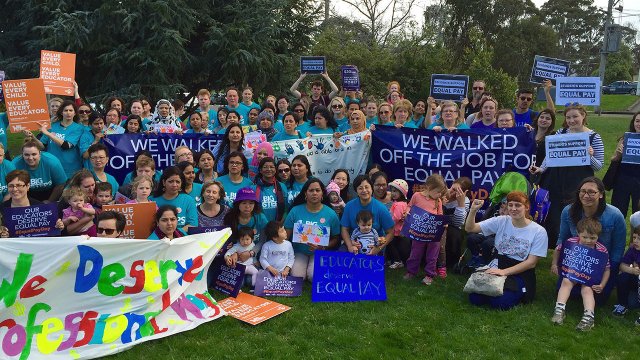
The childcare workers’ strike on International Women’s Day caused me to reflect on the long journey towards equal pay and my personal experience over 50 years of my working life.
My first job as a student was as a conductor on Sydney buses from 1964 to 1966. Bus conductors and teachers were the only jobs that paid women the same rates as men, because there were “manpower” shortages in these industries. However, it was not until late 1966 that women conductors could be promoted to drivers.
The union was very public on the job. A desk was set up next to where we collected our pay (in cash in those pre-digital days) for us to pay our dues and take up any issues with our union rep.
It was a closed shop. You had to be a union member to be employed. When I worked in local government in Adelaide in the 1990s it was also a closed shop. I think we have Prime Minister John Howard and WorkChoices to “thank” for the demise of closed shops.
After graduating I went to work in the public service in Canberra. I sometimes regretted rejecting the Depot Master’s offer of a permanent job as a bus conductor with progression to driver. Women in the public service were paid 80% of the male wage; it would be six years before I was paid the equivalent of a bus driver’s wage.
Just before I became a Commonwealth public servant in December 1966 the “marriage bar” was removed, meaning that women no longer had to resign when they got married. It was normal practice in job interviews for women to be asked their marital and pregnancy status and future plans. Men were never asked these questions. The public service was a male-dominated environment. Workplace discrimination against women was based on women’s perceived role in the family.
When I was elected in 1967 to be a delegate to the Administrative and Clerical Officers Association (ACOA) branch conference — the union then covering public servants — I was the only woman among more than 100 delegates. I was also the youngest at 21 year’s old — most delegates were over 40. The branch, controlled by the right-wing National Civic Council, referred to delegates as “brother”, so I posed a linguistic, as well as political, problem for them.
As the second wave of feminism gained momentum, the ACTU launched the Working Women’s Charter. This provided a framework for women unionists to organise within and across unions. It was a contributing factor in the shift to the left in the ACOA. In the 1970s the ACOA held national plebiscites of union members in opposition to uranium mining and in favour of abortion rights — both of which were seen as industrial issues.
I was promoted several times in my first six years in the public service and ended up supervising men years younger than me, with the Intermediate Certificate (Year 10 equivalent) as their highest qualification. But, even though these young men were many job classifications below me, they were paid more than me.
It was not until December 1972 that women in the Commonwealth public service were granted equal pay. The granting of 12 weeks maternity leave on full pay soon followed.
I retired at age 67 in 2012 after spending the last six years of my working life as a community sector worker in Brisbane. Although men and women in the community services industry were on the same pay rates, they were extremely low in comparison to state and local government workers. My salary fell by $20,000 when I moved from a job in local government in Sydney to Brisbane.
As a bookend to my career, I was centrally involved in the Pay Equity Campaign of the Australian Services Union (ASU) in 2007–08. The campaign was successful and in 2009 the Queensland Industrial Court ruled on the ASU Queensland Branch’s pay equity claim.
It recognised work in the social and community services sector had been historically undervalued as it was seen as caring work and an extension of women’s work in the home. Pay rises of between 17% and 38% were awarded to rectify this gender inequity.
More than 30 years after “equal pay for work of equal value” was formally achieved in Australia, overall, women’s wages are still two-thirds of male wages because of Australia’s gender-segregated workforce. This will be exacerbated with the current attack on penalty rates, which impacts more on women workers.
Following the success of the Queensland Pay Equity Campaign a national claim was lodged with the Fair Work Commission in 2010 and was successful in 2011.
I pay tribute to the fight of the childcare workers and those other valiant women fighting to keep their penalty rates. The torch has been passed to a new generation of women workers.
Today, we are on the verge of a third wave of the women's movement. Young feminists, please accept my solidarity and benefit from the experiences of previous generations of women. You have a wonderful heritage to draw on from socialist revolutionaries Alexandra Kollanti, Clara Zetkin and Celia Sanchez to the women fighters of Rojava today. The future is yours.
Like the article? Subscribe to Green Left now! You can also like us on Facebook and follow us on Twitter.